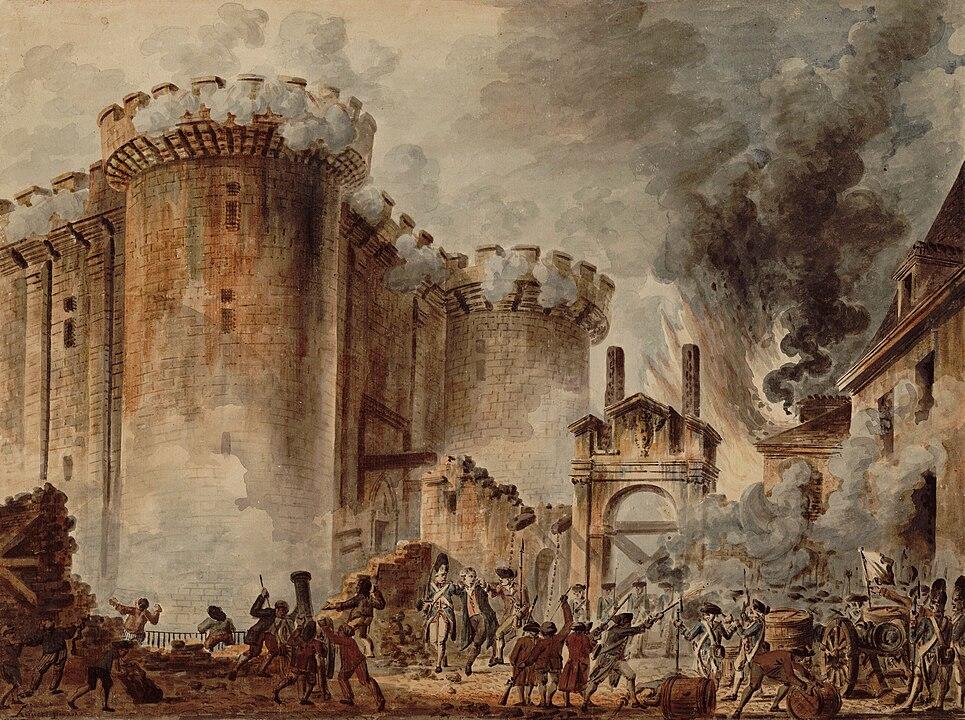Chapters
The Fall of the Bastille or the “Storming of the Bastille” is a moment that is often referenced in European history. Far more than just being a general knowledge question, it was seen as a pivotal part of the history of France, and the moment social pressures boiled over.
The events of July 14th, 1789, stand as an iconic moment in history, marking the onset of the French Revolution. The Bastille, a formidable fortress and state prison located in Paris, had come to symbolise the despotism and oppression of the absolute monarchy. Its fall signalled the uprising of the French people against royal authority and the beginning of a huge societal transformation.


Events Leading Up to the Storming of the Bastille
In the years preceding the storming, France was gripped by economic turmoil exacerbated by King Louis XVI's extravagant spending and a regressive tax system that burdened the commoners while exempting the nobility and clergy. The meeting of the Estates-General on May 5, 1789, to address the financial crisis led to the emergence of the National Assembly on June 17, as the Third Estate demanded greater representation and equality.
This would eventually lead to the end of representation that was based on the traditional social classes, but the mood among the general population in Paris was angry.
Tensions escalated with the king's dismissal of reformist ministers and the rumours of a royalist crackdown on the burgeoning revolutionary movement.
In the time leading up to the Storming of the Bastille, large crowds would meet at Palais-Royal in Paris, where there were political speakers and revolutionaries. Demonstrations continued, and this became worse when Finance Minister Jacques Necker was dismissed on 12th July, signalling yet more chaos.
The people of Paris were also scared that Louis was determined to take back his power by force through his army.
The Day of July 14th, 1789
July 14, 1789, dawned with palpable tension in Paris. Rumours were circulating that King Louis XVI, alarmed by the growing unrest, was mobilising troops to suppress the National Assembly. In response, Parisians, armed with makeshift weapons, gathered outside the Bastille, seeking to secure arms and ammunition to defend themselves and the revolution.
An extract from the London Gazette from Saturday 18 July to Tuesday, July 21, 1789, sets the scene of the time:
“A general Consternation prevailed throughout the Town. All the Shops were shut; all public and private Employments at a Stand, and scarcely a Person to be seen in the Streets, except the armed Burghers, who acted as a temporary Police for the Protection of private Property, to replace the established one, which had no longer any influence.”
The crowd swelled in size and fervour as the population were hungry from poor harvests as well as angry with the state of the country. Governor Bernard-René de Launay, commander of the Bastille, found himself increasingly isolated and besieged. Negotiations between Launay and the mob proved futile, with demands for the fortress's surrender growing ever more insistent.
In the afternoon, rebel companies from the French Guard and defecting soldiers joined the crowd. Second Lieut. Jacob-Job Élie and Pierre-Augustin Hulin helped with organising the revolutionaries and helped them with weapons.
Governor Bernard-René Jourdan de Launay is said to have wanted to blow up the gunpowder stored in the area, but his staff talked him out of this drastic and violent move.
Sensing the inevitability of the situation and faced with dwindling supplies and the prospect of imminent assault, Launay reluctantly capitulated. The drawbridge was lowered, and the gates were opened, allowing the frenzied crowd to surge into the Bastille.
What followed was a chaotic scene of jubilation and chaos as the revolutionaries freed the handful of prisoners (just seven) held within the fortress and seized its cache of weapons and ammunition. The fall of the Bastille reverberated across Paris, igniting celebrations and marking a decisive victory for the people against tyranny.
The Lasting Effects of the Storming of the Bastille
The long-suffering French population had lost their patience, and this event was a huge part of their demand for change and reform in the country.
The lasting effects of the Storming of the Bastille included…
Symbolism
The storming of the Bastille became an enduring symbol of popular resistance and the power of the people to overthrow oppression. It inspired hope and solidarity among the revolutionaries and struck fear into the hearts of the monarchy and aristocracy.
Acceleration of the Revolution
The fall of the Bastille galvanised revolutionaries and brought more and more power to the people, leading to further uprisings and the rapid dismantling of feudal privileges and institutions. The National Assembly seized the momentum to enact sweeping reforms aimed at creating a more just and equitable society.
Redistribution of Power
The storming of the Bastille instilled fear in the ruling elite, prompting mass emigration of nobles and the flight of King Louis XVI and his family. This deepened the crisis of legitimacy for the monarchy and hastened its eventual downfall.
Real power had passed away from the King and would eventually go to elected representatives of the people. Louis now shared power with the National Assembly. Many of the so-called elites and members of the monarchy and nobility even fled the country at this point for fear of what would face them.
Formation of the National Guard
In response to the escalating unrest, the National Assembly established the National Guard, a citizen militia tasked with maintaining order and defending the revolution. This marked a significant shift in power away from the monarchy towards the people.
Global Impact
The storming of the Bastille sent shockwaves across Europe and beyond, inspiring oppressed peoples to rise against their rulers in pursuit of liberty and equality. It symbolised the ideals of the Enlightenment and sparked revolutionary movements worldwide, as peasants and oppressed people felt empowered by the actions of the working classes in France.
In summary, the Storming of the Bastille was a transformative event that signalled the dawn of a new era in French and world history. Its legacy endures as a testament to the power of popular uprising and the quest for freedom and justice.








